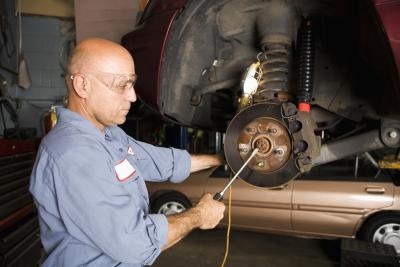
The power brake booster performs an important function in a vehicle's braking system. The power booster, which is attached to the firewall, connects directly to the master cylinder. The power booster uses vacuum from the engine to amplify foot pressure on the brake pedal so that the least amount of force has to be used to stop even the heaviest of vehicles. Without a power booster (on a vehicle that requires one) the vehicle could not stop without extreme force.
When the power booster's internal parts fail, it causes a very hard pedal. When the master cylinder seal leaks into the booster, it contaminates and ruins the internal diaphragm. Replacing a power booster requires a few simple tools and steps.
Place the vehicle in "park" or "neutral," with the emergency brake set. Raise the hood and disconnect the negative battery cable with a socket and ratchet wrench. Look at the master cylinder lid. If it has a sensor wire attached to it, disconnect it and place out it out of the way.
Use the correct brake line wrench to loosen the flare nuts on the brake lines that attach to the master cylinder body. Once removed, pull the lines away to provide clearance--do not forcefully bend the lines. Place rags under the master cylinder to catch any brake fluid drippings. Pull the large vacuum hose from the grommet-lined hole in the brake booster and let it hang.
Go under the dash board and disconnect the linkage arm from the power booster to the brake pedal. Most will come off if you use needle nose pliers to remove the retaining clip. Use the correct end wrench to loosen and remove the two master cylinder mounting bolts. Pull the old piston pin from the rubber hole in the brake booster and set it aside. Secure the master cylinder in a bench vice.
Use the correct socket and ratchet wrench to loosen and remove the four power booster mounting nuts. Pull the power booster unit off the studs and discard it. Place the new power booster over the mounting studs and screw the nuts back on. Tighten the nuts with the correct socket. Go under the dashboard and reattach the linkage arm that connects the power booster to the brake pedal. Slide the retaining clip back into position, locking the arm to the linkage.
Go to your bench vice and fill the master cylinder reservoir with brake fluid. Clean the piston port with carburetor cleaner. Make sure you install the piston pin back into the new power booster hole. Install the master cylinder back onto the power booster, aligning the piston pin with the master cylinder port. Screw the nuts back on with an end wrench or socket and tighten them.
Use your hand to align and start the brake line nuts into the master cylinder threaded holes. Tighten them with the brake line wrench. Have your assistant sit behind the wheel and pump the brake pedal up and hold it. Carefully loosen a brake line nut with the line wrench only enough to let brake fluid seep from the nut connection. Tighten it and tell your assistant to pump the pedal up again and hold it. Loosen the same nut, allowing the air to escape. Tighten the nut. Repeat the same procedure on the other line wrench nut, removing all the air. Replace the fluid as needed, and then place the master cylinder cap back on.
Reconnect the large vacuum hose nipple back into the grommet-lined fitting on the power booster. Make sure the fitting has a tight seal. Reconnect the sensor wire on the top lid of the master cylinder. Reconnect the negative battery cable with the correct socket and wrench. Start the engine. You should have a high pedal with about ½-inch of free play from the top of the brake pedal position to where it feels solid after downward pressure. Test drive the vehicle and note the brake performance.